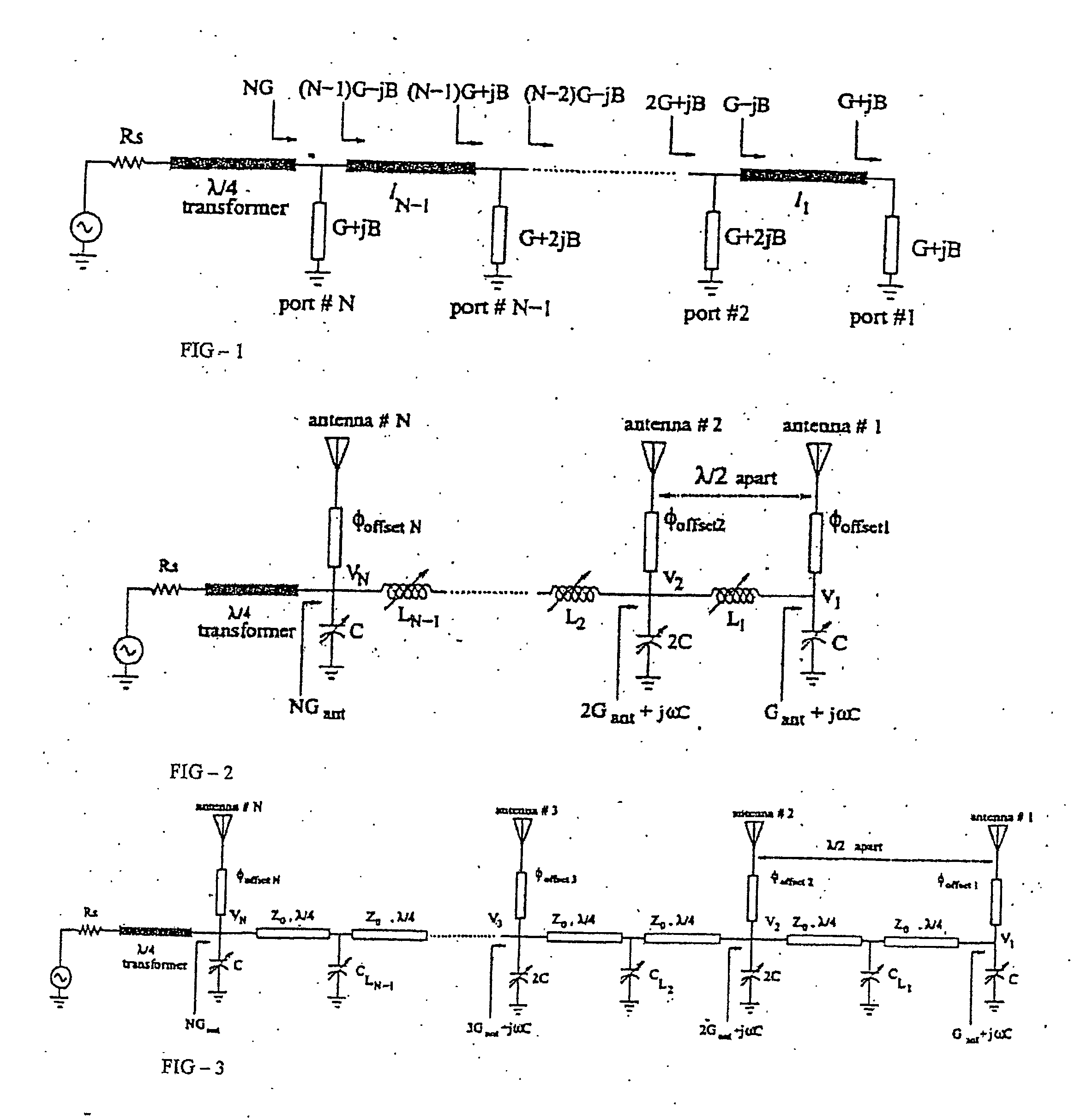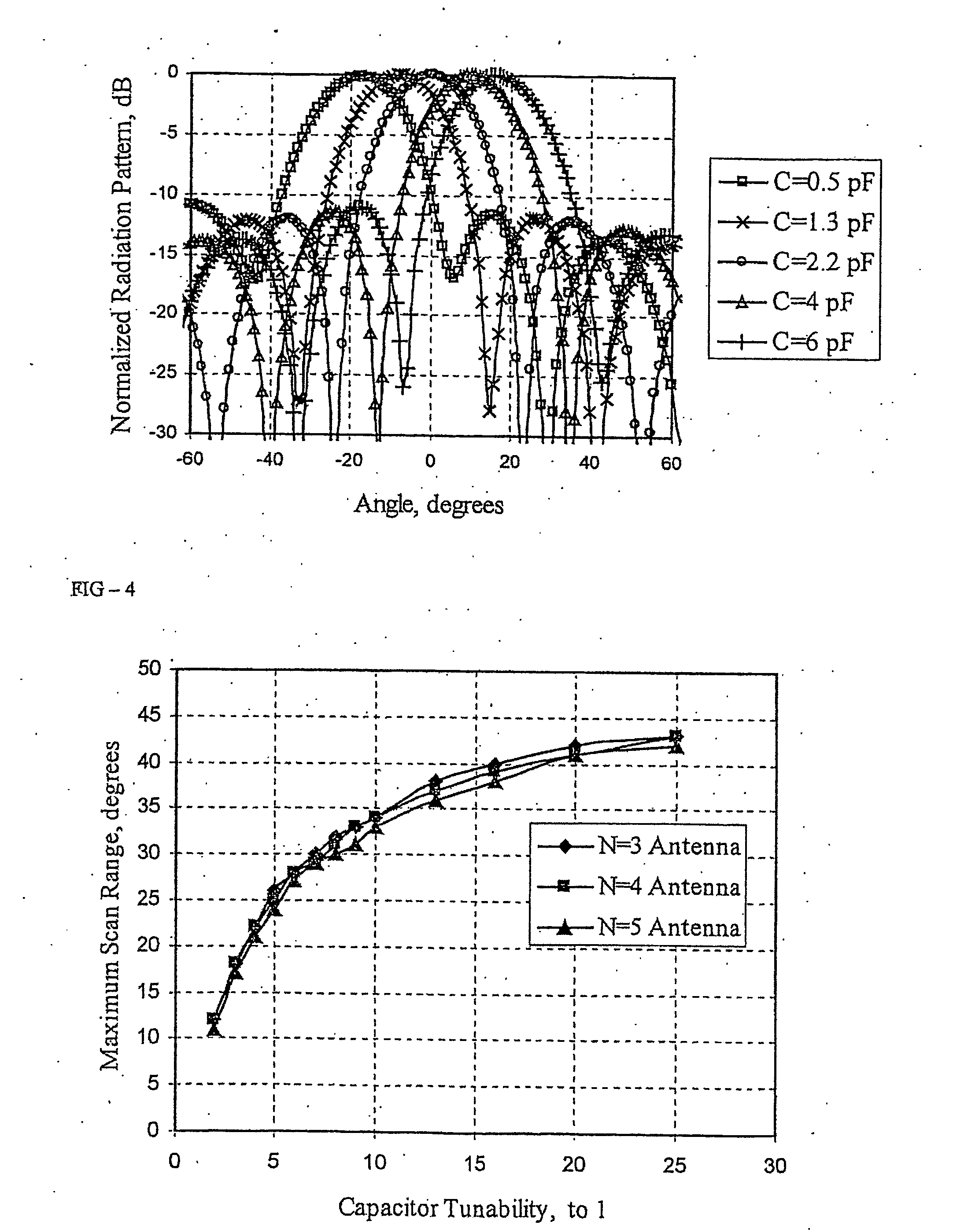Phased array antenna with extended resonance power divider/phase shifter circuit
- Summary
- Abstract
- Description
- Claims
- Application Information
AI Technical Summary
Benefits of technology
Problems solved by technology
Method used
Image
Examples
example 1
[0049] To demonstrate the operation of this technique, a two GHz extended resonance based phased array including four edge coupled microstrip patch antennas placed half wavelength apart was designed, fabricated and tested. A 31 mil thick RT / duroid 5880 substrate from Rogers Corporation was used to build the phased array. MSV34 series chip varactor diodes from Metelics Inc. were used as tunable capacitors. A photo of the phased array can be seen in FIG. 7. The overall size of the phased array was 39×25 cm2. The measured H-plane pattern of the phased array for various diode voltages is shown in FIG. 8 and the measured performance is summarized in Table 1. The results show that the phased array can scan the beam + / −13.5 degrees with the application of 2 V to 30 V reverse bias to the varactor diodes. The side lobe level was better than 7 dB. The gain of the phased array was measured to be 8.3 dB at 30 V reverse bias applied to the varactors. It can be seen from FIG. 8 that the gain at 2...
example 2
[0057] A 10 GHz extended resonance based phased array including 8 microstrip patch antennas has been designed, fabricated and tested. The antennas were half wavelength apart. A 15 mil thick TMM3 substrate from Rogers Corporation was used to build the phased array. MA46580 series beam lead varactor diodes from MACOM Inc. were used as tunable capacitors. A photo of the phased array is shown in FIG. 9. The overall size of the phased array was 11.4×3 cm2 (except for the bias lines and input feed line). The measured H-plane pattern of the phased array for various diode voltages is shown in FIG. 10. The preliminary measurement results show that the phased array can steer the beam 18 degrees with the application of 2.25 V to 10.2 V reverse bias to the varactor diodes. The measured side lobe level was better than 10 dB. It can be seen from FIG. 10 that the gain of the phased array decreases as the diode voltage is reduced to 2.25 V. This is due to the low quality factor of the varactor diod...
example 3
[0063] Based on the theory outlined, simulated array factor for a 4-antenna extended resonance phased array for various normalized capacitive susceptances is shown in FIG. 18 (antennas are λ / 2 apart). The simulated scan range is 21 degrees for the varactor tunability of 3.2:1. In this simulation, the varactors and transmission lines were assumed to be lossless. The effect of finite varactor quality factor (Q) on the efficiency of the extended resonance array feed has also been studied. The equivalent circuit model for the varactor is shown in FIG. 19 and its associated quality factor is given in equation (17). Q=ω CGC(17)
[0064] Therefore, at the power divider ports, some portion of the divided power is radiated through the antenna with input conductance of Gant, and the rest is dissipated within the varactors through their shunt conductances. Assuming all the varactors in the circuit have the same quality factor, the efficiency of the extended resonance phased array feed can be c...
PUM
 Login to View More
Login to View More Abstract
Description
Claims
Application Information
 Login to View More
Login to View More - R&D
- Intellectual Property
- Life Sciences
- Materials
- Tech Scout
- Unparalleled Data Quality
- Higher Quality Content
- 60% Fewer Hallucinations
Browse by: Latest US Patents, China's latest patents, Technical Efficacy Thesaurus, Application Domain, Technology Topic, Popular Technical Reports.
© 2025 PatSnap. All rights reserved.Legal|Privacy policy|Modern Slavery Act Transparency Statement|Sitemap|About US| Contact US: help@patsnap.com



